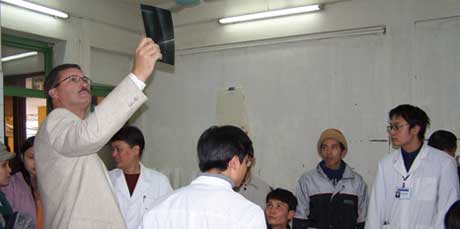The airport was clean and efficient. The young visa agents were typically impersonal in their crisp green military uniforms. And before long we were packed into a cab headed into the heart of Ha Noi.
Soon, my wife and I were wading through the thousands of motorbikes that crowded every street. “Just walk slowly across the street,” the guidebook had said. “Don’t stop. And most of all, don’t run. They will miss you.” And sure enough, like the parting of the Red Sea, we walked across the five lanes of whizzing traffic without a scratch. The streets were lined with beautiful old buildings, evidence of the French colonial era, which stood in contrast to the ancient Chinese temples. It was clear that the Vietnamese both loved and hated their history of foreign influences.
While driving through the countryside we asked our Vietnamese guide about the North’s feelings for their cousins in the South. “Saigon, I guess it’s now Ho Chi Minh City, is much more developed than Ha Noi,” I began.
“Yes,” our guide said, “but the people are lazy. They do not have the ethical values of those in the North.”
“Why is that?” I asked naively.
“They were given everything by the Americans.”
Later our guide asked us if we wanted to stop at a factory store where beautiful works of art were made by disabled children. How could we say no? Upon our arrival we noticed that each visitor was lead through the facility by an ultra polite sales assistant who spoke perfect English. Some children were making intricate paintings using fragments of egg shells. Despite spending the entire day hunched over a palate of glue, most only wore simple cloth masks. Other children embroidered beautifully intricate free-hand ‘paintings’. I couldn’t help but ask about their conditions. “They are the victims of Agent Orange,” our guide told us very matter-of-factly.
“But none of them are old enough to have experienced the effects of the Vietnam War,” I started to argue. These children sat quietly working in the middle of the giant shop for all the crowds of foreign shoppers to view. You would have called it a ‘sweat shop’ except that the temperature was in the 40’s and the building was unheated. After toiling all day, the children were moved to a similarly unheated barn-like adjacent dormitory to sleep. Despite the thousands of dollars and other foreign currencies being spent there, it was obvious that the children saw little benefit from the profits. “They’re ‘victims’ alright,” I said.
Driving further through the countryside I noticed more than a few large beautiful homes. “Who lives in homes like that?” I asked our guide.
“Party officials,” he responded without hesitation or any noticeable resentment.
“We have the same problem in our country,” I joked sarcastically. “Politicians who have never held meaningful employment somehow end up being multi-millionaires. Go figure.” It was clear the idiom and possibly the sentiment was lost in translation.

“Four million,” he responded without blinking.
I inhaled very slowly before responding. “OK. Can we go look at your major trauma center?”
“Certainly,” he said proudly with a slight bow.
The hospital consisted of a group of buildings built by the French sometime in the last century. The ED entrance looked like any other hospital, except that it had no doors, only an open passageway through which the cold damp weather came right into the hospital. There was a large crowd around a woman logging people into a book. One man was carrying his child with a homemade splint on his leg. Another elderly woman cradled her arm with the classic ‘silver fork deformity’ of a Colles fracture. Despite their obvious distress, all the patients were quiet and respectful. The presence of young medical students everywhere added to the seeming chaos. Our physician guide was pleased to show me the X-rays of the injured.
The trauma resuscitation room had four people being seen at the same time. All were intubated and comatose, but none were being ventilated. No one seemed to mind as I compulsively wandered through the room performing my own trauma exam. All the injuries would have challenged the best US trauma center. I doubted that these patients had much of a chance in this limited setting. Moving to the neuro intensive care unit, I saw a room packed with patients surrounded by the latest equipment. Each patient seemed to be cared for by shabbily-dressed family members in yellow cover gowns assisted by two nurses. It was the one room in the hospital that was heated.
“The equipment was all purchased by USAID and other western country governments,” our guide stated, answering the question that was hanging in the air.
“And the family members, where to they stay?”
“I show you,” he said cheerily leading to a warehouse-size building adjacent to the hospital. “The University of Sydney donated this.” Inside were over 350 bunks with thin woven mats on plywood boards. Crowds of people bustled about, some changing clothes in the open room, some cooking, some trying to sleep in all the activity. One elderly woman caught my eye as she sat motionless on her bunk. “She is here getting chemotherapy each day,” our guide noted.
“Well, this is certainly one way to keep costs down,” I mused thinking about America’s current cost cutting proposals.
“Yes,” I said with a modest bow of my much larger frame. “Let’s keep in touch.”



